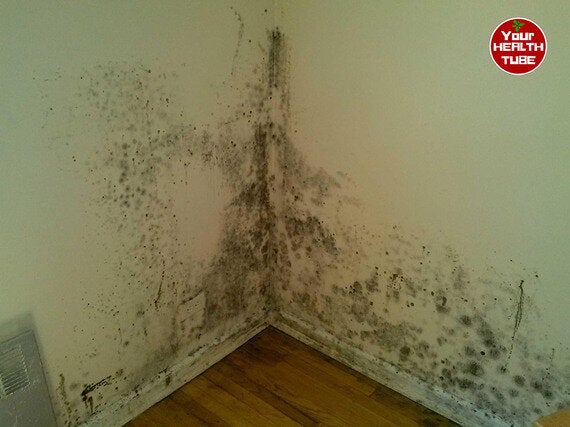
Image Credit: yourhealthtube.com
There is always some damp and mould everywhere - on many surfaces and in the air. Mould has been on the planet for millions of years. It grows where there is moisture. Thus, mould health issues are some of the most widespread health problems all over the world.
Nowadays, mould growth in places of work and homes is more of a health problem than we may think. Therefore, it is important that you recognise the symptoms of mould in your house, and take steps to protect yourself and your family.
How does mould affect your health?
Moulds produce allergens (which are substances that cause an allergic reaction), irritants and, often, toxic substances. Touching or inhaling mould spores can cause an allergic reaction, such as a runny nose, sneezing, skin rash, and red eyes. Moulds may also cause asthma attacks.
Symptoms of Mould Health Issues
The severity and type of health effects which result from moulds exposure are variable among different places, from person to person and over time.
Even though difficult to predict, exposure to damp and mould growing indoors is most often linked with certain allergy symptoms. Commonly, indoor moulds exposure leads to upper respiratory tract symptoms, including:
•Nasal and sinus congestion
•Sore throat/cough
•Chest tightness
•Asthma (or exacerbation of it)
•Dyspnea (breathing difficulty)
•Skin and eye irritation
•Upper respiratory tract infections
•Epistaxis (nosebleed)
Moreover, some indoor mould is capable of producing exceedingly potent toxins (mycotoxins) which are lipid-soluble and willingly absorbed by the intestinal lining, skin, and airways. These agents, usually contained in the fungal spores, have poisonous effects ranging from short-term irritation to cancer and immunosuppression.
Who is affected?
Damp and moulds can affect the immune system. Some people are more sensitive than others. Accordingly, long standing exposure to indoor mould is truly harmful to anyone, however, certain groups of people will develop more serious symptoms sooner than others, including:
•Babies and children
•Elderly people
•Persons with respiratory conditions, asthma, and/or allergies
•People with a weakened immune system
These individuals should stay away from damp and mould.
Causes of Damp and Mould
Damp and mould are initiated by excess moisture. Dampness in buildings may be triggered by rising damp in ground floors or basements, leaking pipes, or rain seeping around window frames or in the room because of damage to the roof.
A newly-built house could be damp if the water used when building it's still drying out - for instance, in the plaster on the walls - which is one of the most common cases in numerous new buildings today and can cause serious mould health issues.
Condensation can also cause excess moisture indoors and is one of the greatest causes of damp and mould. Following you can find more about this issue and how to prevent condensation.
How to Prevent Condensation?
Here are some tips that can help you prevent the build-up of condensation in your home:
•avoiding using paraffin or bottled gas heaters, drying washing outside, and putting lids on saucepans;
•opening the bedroom window for about 15-20 minutes every morning;
•heating your home a little more;
•making sure your house is well insulated;
•leaving doors open and ventilating rooms regularly to allow air to circulate, unless you're showering or cooking, and
•if you're showering, bathing, or cooking - putting the fan on, opening the window, and closing the door of the room you're in.
In order to improve ventilation or to get rid of leaks, you may need to do certain repairs in your house. Once your home has been repaired, or if your house is damp due to its newly built, it might take weeks of ventilation or heating it to dry it out. This will help you prevent mould health issues.
How Do I Get Rid of Damp and Mould?
Once you've identified and fixed the cause of moisture in your house you can remove any mould. You may be able to eliminate mould yourself, or you may need to get a professional to eliminate it.
Though, you can only remove mould yourself if it is initiated by condensation and covers an area less than 1 m. squared (3x3 feet or 1x1 meter). Do not try to remove the mould yourself if it is initiated by sewage or other contaminated water.
•Protect yourself from damp and mould spores by wearing long rubber gloves, goggles, and a mask that covers your mouth and nose. Open the window but keep the door closed in order to prevent bacteria spreading to other places of the house;
•Take a plastic bag so you can take away any soft toys, clothes, and soft furnishings that are mouldy. Soft furnishings should be rinsed and clothes dry cleaned.
•Mix some with mild detergent (such as a soup or washing up liquid used for hand-washing clothes) in a bucket;
•Use a rag dipped in the foamy water to carefully wipe the mould off the wall. But, be careful not to brush it - because this can release mould spores;
•When you've done, use a dry rag to take out the moisture from the wall;
•After that, put the rag in a plastic bag and throw it away,
•All the surfaces in the room must be thoroughly cleaned by either vacuuming or wet wiping to remove any spores.
Find out: Why Everybody's Talking About GAPS Diet?
If you liked our article, please like our Facebook Page.
This article originally appeared at yourhealthtube.com
Sources:
https://www.cdc.gov/mold/dampness_facts.htm
http://www.nhs.uk/chq/Pages/Can-damp-and-mould-affect-my-health.aspx?CategoryID=87
http://enhs.umn.edu/current/5103/molds/harmful.html